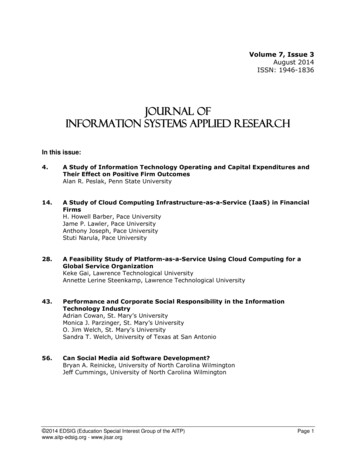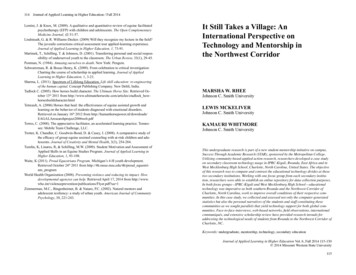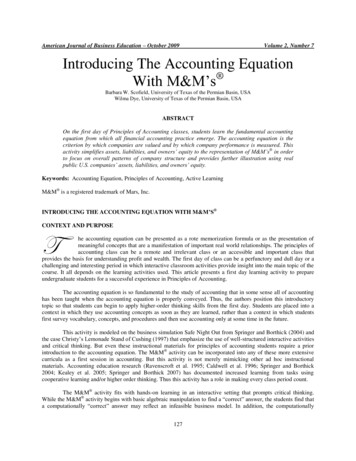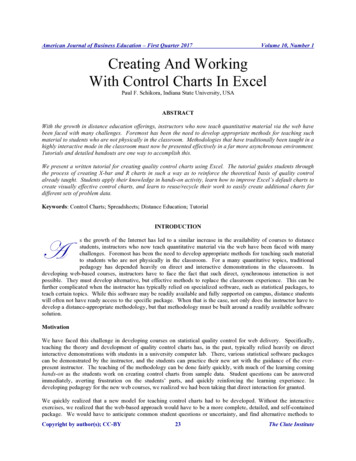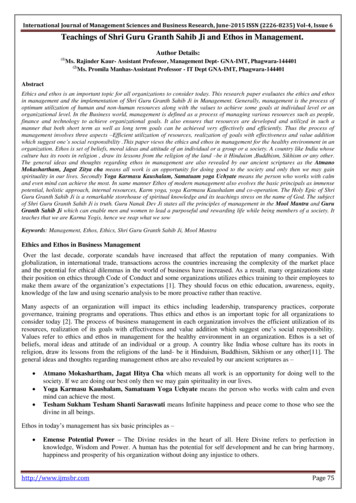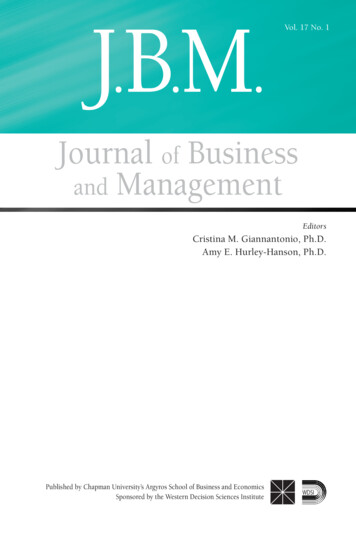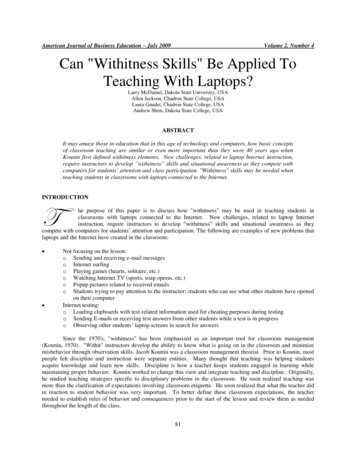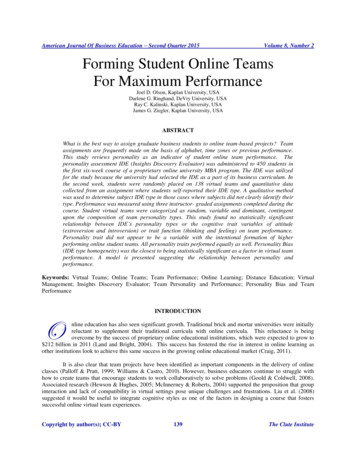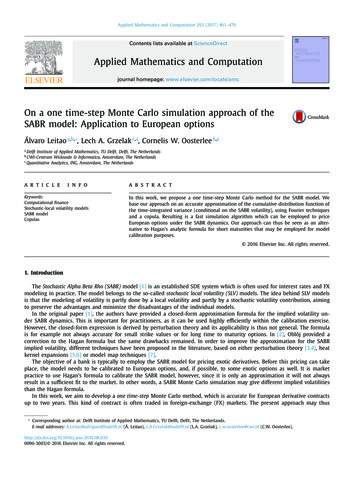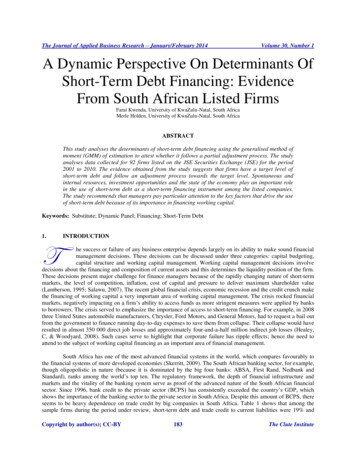
Transcription
The Journal of Applied Business Research – January/February 2014Volume 30, Number 1A Dynamic Perspective On Determinants OfShort-Term Debt Financing: EvidenceFrom South African Listed FirmsFarai Kwenda, University of KwaZulu-Natal, South AfricaMerle Holden, University of KwaZulu-Natal, South AfricaABSTRACTThis study analyses the determinants of short-term debt financing using the generalised method ofmoment (GMM) of estimation to attest whether it follows a partial adjustment process. The studyanalyses data collected for 92 firms listed on the JSE Securities Exchange (JSE) for the period2001 to 2010. The evidence obtained from the study suggests that firms have a target level ofshort-term debt and follow an adjustment process towards the target level. Spontaneous andinternal resources, investment opportunities and the state of the economy play an important rolein the use of short-term debt as a short-term financing instrument among the listed companies.The study recommends that managers pay particular attention to the key factors that drive the useof short-term debt because of its importance in financing working capital.Keywords: Substitute; Dynamic Panel; Financing; Short-Term Debt1.INTRODUCTIONThe success or failure of any business enterprise depends largely on its ability to make sound financialmanagement decisions. These decisions can be discussed under three categories: capital budgeting,capital structure and working capital management. Working capital management decisions involvedecisions about the financing and composition of current assets and this determines the liquidity position of the firm.These decisions present major challenge for finance managers because of the rapidly changing nature of short-termmarkets, the level of competition, inflation, cost of capital and pressure to deliver maximum shareholder value(Lamberson, 1995; Salawu, 2007). The recent global financial crisis, economic recession and the credit crunch makethe financing of working capital a very important area of working capital management. The crisis rocked financialmarkets, negatively impacting on a firm’s ability to access funds as more stringent measures were applied by banksto borrowers. The crisis served to emphasize the importance of access to short-term financing. For example, in 2008three United States automobile manufacturers, Chrysler, Ford Motors, and General Motors, had to request a bail outfrom the government to finance running day-to-day expenses to save them from collapse. Their collapse would haveresulted in almost 350 000 direct job losses and approximately four-and-a-half million indirect job losses (Healey,C, & Woodyard, 2008). Such cases serve to highlight that corporate failure has ripple effects; hence the need toattend to the subject of working capital financing as an important area of financial management.South Africa has one of the most advanced financial systems in the world, which compares favourably tothe financial systems of more developed economies (Skerritt, 2009). The South African banking sector, for example,though oligopolistic in nature (because it is dominated by the big four banks: ABSA, First Rand, Nedbank andStandard), ranks among the world’s top ten. The regulatory framework, the depth of financial infrastructure andmarkets and the vitality of the banking system serve as proof of the advanced nature of the South African financialsector. Since 1996, bank credit to the private sector (BCPS) has consistently exceeded the country’s GDP, whichshows the importance of the banking sector to the private sector in South Africa. Despite this amount of BCPS, thereseems to be heavy dependence on trade credit by big companies in South Africa. Table 1 shows that among thesample firms during the period under review, short-term debt and trade credit to current liabilities were 19% andCopyright by author(s); CC-BY183The Clute Institute
The Journal of Applied Business Research – January/February 2014Volume 30, Number 170%, respectively. In addition, while trade credit financed half of the current assets held by these firms, short-termdebt financed less than a fifth. According to Fisman and Love (2003), supplier credit is an alternative for firmsoperating in underdeveloped financial markets.Table 1 shows that firms marginally increased their use of short-term debt as a source of finance during theeconomic slowdown periods 2003–2004 and 2007–2009, and reduced their use of the same when the economy wasdoing well. The South African financial sector was somehow insulated from the global financial crisis and this hasbeen attributed to the implementation of the National Credit Act (NCA) in 2007. These statistics leave one askingquestions such as, what determines the use of short-term debt financing among listed firms in South Africa, and,what was the impact of the financial crisis on short-term debt used by big firms?The study contributes to the body of knowledge by providing evidence on whether short-term debt followsthe partial adjustment like trade credit (García-Teruel & Martínez-Solano, 2010) and debt ratio (Ozkan, 2001). Oursecond contribution is an analysis of the impact of the global financial crisis on the short-term debt used by firmslisted on the JSE. To the best of our knowledge, no study of this nature has been conducted.2.LITERATURE REVIEWAccording to Modigliani and Miller (1958), under perfect capital markets a firm’s investment decisions areindependent of its financial situation. In the absence of capital rationing, external financing can be accessed withoutdifficulties, and a firm’s expected future profitability should drive investment. However, modern financial andeconomic theories agree that real investment may be influenced by financial factors.The matching principle in finance states that current assets, which are mainly made up of cash and nearcash items, inventory, receivables and prepayments, should be financed by current liabilities, which comprise shortterm debt, accruals and accounts payable. Non-current assets or fixed assets (plant, equipment, machinery, land andbuildings) should be financed by long-term loans, debentures and equity. The matching of assets and liabilitiesmaturity ensures that a firm avoids frequent refinancing and maturing obligations are met from cash flows generatedby the business (Firer, Ross, Westerfield, & Jordan, 2012). The matching principle means that the firm avoids usingexternal funds thereby minimizing the agency problems between the interests of equity holders and debt providers(Myers, 1977).2.1Sources of Working Capital FinancingThe two main sources of short-term funds are spontaneously generated sources such as accounts payable,provisions and accruals, and non-spontaneously generated sources such as unsecured and secured short-termborrowings and off-balance sheet financing instruments. Marx, de Swardt, Beaumont Smith, and Erasmus (2011, p.188) state that spontaneous sources of financing arise from the ordinary course of business, are directly related to thesales level, and increase or decrease in direct proportion to sales. Secured short-term borrowings are usually madeup of short-term bank loans, cash credit overdraft, and working capital demand loans. Unsecured financing (alsoknown as financial statements lending) is short-term financing obtained from the money market without pledgingany specific assets as collateral, and include negotiable certificates of deposit (NCD), commercial paper andbanker’s acceptances (BAs). BAs, however, are no longer active on the South African money market.The most common term structure of interest rates is upward sloping, which means that long-term debtattracts higher interest rates than short-term debt (Firer et al., 2012). Firms may finance their long-term assetsrequirements with short-term debt in order to take advantage of lower interest rates. However, this exposes the firmto refinancing risk. Refinancing risk is made up of default risk and interest rate risk. Default risk arises whenlenders, for whatever reason, decide not to renew the firm’s debt contract and the firm has insufficient capital toredeem such debt. Interest rate risk is the risk that the firm’s interest expense might rise due to refinanced debtattracting a higher interest rate. While short-term debt could be preferred to long-term debt because of its lower cost,it is more risky since short-term interest rates tend to be more volatile than long-term interest rates (see Appendix Bfor long-term and short-term interest rates in South Africa between 1970 and 2010). Heavy usage of short-term debtexposes the firm to bankruptcy risk because an inability to repay may hinder the firm’s access to more funding,thereby forcing the firm into bankruptcy (Fosberg, 2012).Copyright by author(s); CC-BY184The Clute Institute
The Journal of Applied Business Research – January/February 20142.2Volume 30, Number 1Bank Credit and Trade CreditThere is no distinct evidence that trade credit and bank credit are substitutes or complements (Love, 2011).Theoretical papers such as Biais and Gollier (1997) and Giannetti, Burkart, and Ellingsen (2008) argue that thesetwo are complements because trade credit conveys information to lenders, and firms that use trade credit borrow atfavourable conditions from banks. However, trade credit compensates for the unavailability of bank creditparticularly for firms operating in poorly developed financial markets. Fisman and Love (2003) argue that tradecredit is a substitute for bank credit. Alphonse, Ducret, and Séverin (2006) provide evidence that trade creditconveys a message about a firm’s quality and thus facilitates access to bank credit.2.3Changes in Short Term FinancingThe level of short-term debt financing changes due to either the size effect or the substitution effect(Fosberg, 2012). The size effect is premised on the matching principle that states that short-term assets should equalshort-term liabilities. The growth in current assets can be financed by spontaneous sources of finance. However, thespontaneous sources may be insufficient to cover all the growth in current assets; hence the need for additionalshort-term funds to support current assets growth. When current assets equal current liabilities, it means the currentratio is 1, which means that the firm has a Rand/Dollar in current assets to pay off every Rand/Dollar in currentliabilities. However, as a risk management technique, firms tend to maintain a current ratio higher than 1 requiringmore funding, and this portion is met using long-term funds.The substitution effect implies that there is an inverse relationship between spontaneously-generatedresources and short-term debt financing. Holding current assets constant, an increase in the firm’s spontaneouslygenerated resources reduces the firm’s need for short-term debt financing. Spontaneous sources of finance includeaccounts payable/trade credit and accruals (tax liability and dividends declared but not yet paid). Conversely, areduction in spontaneous sources of financing increases the need for more short-term debt.2.4Other Factors Influencing the Use of Short-Term Debt FinancingIn a number of respects, short-term debt finance and long-term debt are similar. Consequently, factors thatinfluence long-term debt financing such as creditworthiness, non-debt tax shields, access to capital markets, the sizeof the firm, the availability of internal resources, the availability of collateral, investment and growth opportunitiesshould also influence short-term debt financing. Below is a discussion of these factors and development of thehypothesis.2.4.1Firm SizeThe size of the firm has been used to distinguish financially and non-financially constrained firms. Thussize impacts on the ability of the firm to access finance (Carpenter, Fazzari, & Petersen, 1994). Large firms are morediversified and use more debt in their financing structure because financial markets are more accessible to themcompared to small firms and face friendly interest rates when borrowing (Ferri & Jones, 1979; Titman & Wessels,1998). In this study, the natural logarithm of market capitalisation is used as a proxy for size and a positiverelationship between size and short-term debt is hypothesised.2.4.2Availability of Internal ResourcesAccording to the Pecking Order Theory (POT) developed by Myers (1984) and Myers and Majluf (1984),firms follow a hierarchical financing pattern. Firms prefer internal funds (retained earnings) to external funds andwith respect to external funds firms prefer short-term debt to long-term debt and long-term debt is preferred toequity. Following the POT, as the firm generates more internal resources it uses less short-term debt. However, theavailability of internal earnings influences the capacity to service debt. Profitable firms have better capacity toservice their debt and therefore can use more leverage in their financing structure. Less profitable firms are likely tobe less self-sufficient because they have low plough-back profits hence may have increased reliance on short-termdebt finance to finance their activities and asset requirements. The availability of internal resources was measured byCopyright by author(s); CC-BY185The Clute Institute
The Journal of Applied Business Research – January/February 2014Volume 30, Number 1earnings before interest and tax (EBIT) scaled by total assets. As an alternative to trade credit, and based on previousstudies between trade credit and internal resources, we expect EBIT to be inversely related to short-term debt.2.4.3Non-Debt Tax ShieldsNon-debt tax shields, measured by depreciation and amortization, reduce the amount of debt financing thata firm employs because they reduce the expected interest tax shield the debt will generate. These serve as asubstitute for interest expense, which is deductible in the calculation of the corporate tax and are negativelycorrelated to the amount of debt the firm uses in it
The two main sources of short-term funds are spontaneously generated sources such as accounts payable, provisions and accruals, and non-spontaneously generated sources such as unsecured and secured short-term borrowings and off-balance sheet financing instruments. Marx, de Swardt, Beaumont Smith, and Erasmus (2011, p. 188) state that spontaneous sources of financing arise from the ordinary .
